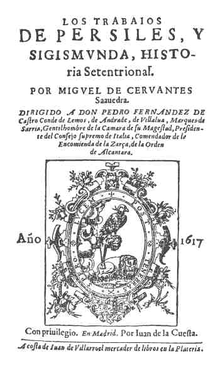Los trabajos de Persiles y Sigismunda
Los trabajos de Persiles y Sigismunda ("The Travails of Persiles and Sigismunda") is a romance or Byzantine novel by Miguel de Cervantes Saavedra, his last work and one that stands in opposition to the more famous novel Don Quixote by its embrace of the fantastic rather than the commonplace.[1] While Cervantes is known primarily for Don Quixote, widely regarded as one of the foremost classic novels of all time, he himself believed the Persiles, as it is commonly called, to be his crowning achievement.[2] He completed it only three days before his death, and it was posthumously published in 1617.[3]
 Title page of first edition (1617) | |
| Author | Miguel de Cervantes Saavedra |
|---|---|
| Original title | Los trabajos de Persiles y Sigismunda |
| Country | Spain |
| Language | Spanish |
| Genre | Romance novel, Byzantine novel |
| Media type | |
The generally accepted idea about the novel's orthodoxy as a Byzantine, neo-classical and Catholic epic romance has been challenged in two books by Michael Nerlich (2005)[4] and Michael Armstrong-Roche (2009).[5] More recently (2016), in a volume of studies celebrating the 400th anniversary of the novel's publication, the editor Mercedes Alcalá Galán points out that new interpretations of the Persiles have led to an expansion of its meaning, and that her volume emphasises the novel's poetic legacy, its inventiveness, and above all the appeal of the writer's creative passion, "el contagio de la pasión literaria con la que fue escrita."[6] The latest attempt to read something new into the novel makes the claim that beneath the disguise of the heroes as Periandro and Auristela there are further surprising identites, both historical and religious, waiting to be discovered.[7]
To mark the 400th anniversary, the Real Academia Española has brought out a new edition (2017), seventy-five pages of which can be found at: http://www.rae.es/sites/default/files/Hojear_Persiles_y_Sigismunda.pdf
References edit
- ^ Sacchetti, Maria (2001). Cervantes' Los trabajos de Persiles y Sigismunda: A Study of Genre. Tamesis Books. ISBN 978-1-85566-077-9.
- ^ "Early Modern Spain: Persiles y Sigismunda".
- ^ Canavaggio, Jean. "Miguel de Cervantes (1547-1616): Life and Portrait". The Cervantes Project. Retrieved 2011-05-21.
- ^ Nerlich, Michael (2005). Le 'Persiles' décodé ou la "Divine Comédie" de Cervantes. Clermont-Ferrand: Presses Universitaires Blaise Pascal. ISBN 2845162944.
- ^ Armstrong-Roche, Michael (2009). Cervantes' Epic Novel: Empire, Religion, and the Dream Life of Heroes in 'Persiles'. Toronto: University of Toronto Press. ISBN 9780802090850.
- ^ eHumanista/Cervantes, vol 5 (2016), p. viii. http://www.ehumanista.ucsb.edu/cervantes/volumes/5
- ^ Hoyle, Alan (2018). Postscript to 'Don Quixote' (1605) and the Puzzle of the 'Persiles' Solved. Burniston: Rocks Lane Editions. ISBN 9781911357827.
External links edit
- The Travels of Persiles and Sigismunda: A Northern History, English translation of Persiles
- Los trabajos de Persiles y Sigismunda at WikiSource